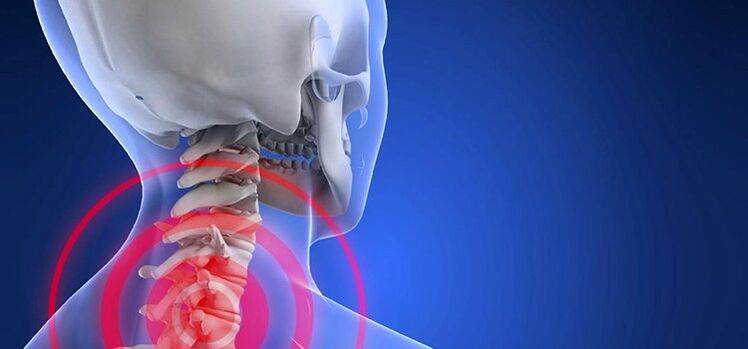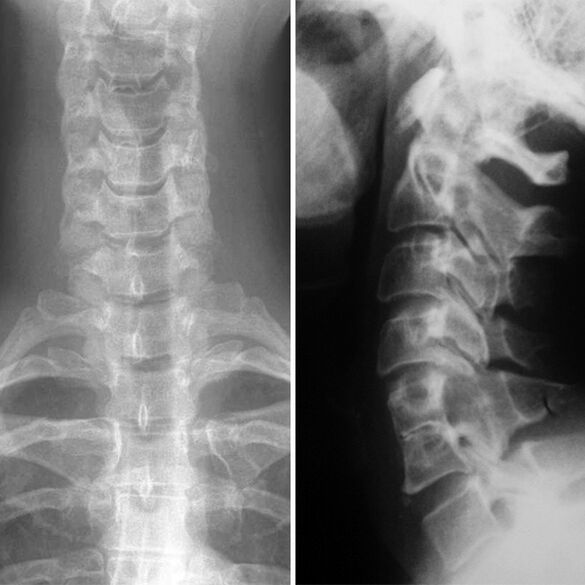
Osteochondrosis of the cervix region is one of the most common diseases in the spine, which can be explained by the great mobility of this body.While the disease develops, serious pain occurs, which significantly deteriorates the quality of human life.That is why the first manifestations of pathology are so important to consult a doctor.
Osteochondrosis of the cervical spine
Violation is progressive and consists of the appearance of dystrophic changes in the slices of the spine.At this place there are seven vertebrae that offer free head movements.Due to an increased physical exertion or inadequate muscles, this spine is often exposed to such an injury.
With the development of the disease, metabolic processes are disturbed in the spine, the strength and elasticity of the intervertebral disc disappears, and increased loads cause cracks to occur on the fibrous ring.While the process is developing, the lead or hernia appears.
The degree of development
- The first degree.The disease results in some symptoms.One person feels small pain in the neck and gains with the head wins.The doctor can identify a small muscle tension during the examination.
- The second degree.This shape is characterized by material pain and you can give it your hand or shoulder.This is due to a violation of the height of the pane, the nerve ports provoked.Pain syndrome becomes stronger when you move your head.Such a condition is characterized by a headache, increased weakness and acceptance of work ability.
- The third degree.The manifestations of the anomaly increases many times over and pain is constantly present.You can not only feel yourself on the neck yourself, but also to influence your shoulder or arm.The formation of a hernia leads to a weakness of the hands.One person complains about chronic tiredness and dizziness.During the examination, the doctor can determine a violation of the mobility of the neck.In addition, the patient is in pain while stopping.
- The fourth degree.At this stage, the intervertebral disc is completely destroyed, which leads to the formation of connective tissue in its place.The dizziness also increases significantly in the patient, the coordination of movements is disrupted and there is noise in the ears.Such symptoms are a result of the use of vertebral artery in the pathological process - it is responsible for the diet of the cerebellum and the area of the brain.
Reasons
The strain on the cervical compartment increases under the influence of various factors.The muscles try to compensate for this process that causes cramps and problems with blood circulation.For this reason, degenerative processes arise.
The main causes of the disease are as follows:
- Lack of motor activity;
- Violation of the metabolism;
- improper attitude;
- Obesity;
- Scoliosis;
- Systematic muscle tension;
- stressful situations;
- dysplastic anomalies of the connective tissue;
- Problems with blood circulation in the neck;
- Inheritance;
- uncontrolled physical activity;
- Anomalies of the spine.
Contrary to the popular opinion, osteochondrosis can not only be identified in older people.Nowadays, such a violation is not unusual for children and adolescents.In addition, the number of illnesses in humans is 18 to 30 years old.
Symptoms and signs of the disease
These or other symptoms of osteochondrosis are available in almost every person.If you are associated with pronounced pain, you should immediately consult a doctor.The signs of pathology include:
- Pain in the neck.You can give the back of the head, shoulder, eyes or ears.Very often they can be felt during the movements.Sometimes there is painful nature.
- Pain in the hands.Discomfort can also be felt in the area of the shoulder, the brush, the forearm, and it remains at night.
- Violation of the activity of the hands and fingers.One person can lose the sensitivity and strength of the muscles.
- Muscle tension in the morning.
- Noise in the ears.
- Headache.As a rule, they begin to feel in mind, and then they can be felt in temples and crown.
- Daubiness and tingling in the limbs.
- Fainting, dizziness, darkening in the eyes.Such signs most often appear with careless movements of the head.
- Doubleity of the language.
- Worse hearing and vision.
- Pain in the heart area.
- Increasing the size of the connective tissue in the neck.
- Sleep disorders, memory, attention.
- Change the voice - the appearance of hoarse, weaker of the voice, etc.
Symptoms of a neck osteochondrosis
Violations of this spine are characterized by such manifestations:
- Systematic headache;
- Interkostal -Neuralgia;
- Print waste;
- Loss of coordination of movements;
- Dizziness;
- chronic fatigue;
- Pain in the heart;
- infectious pathologies;
- flickering points in front of the eyes;
- Noise in the ears;
- Deafness of the fingers;
- Pain in hands and shoulders.
This form of osteochondrosis provokes many syndromes and can lead to problems with the functioning of certain organs.
For example, this pathology often provokes heart disease.If these symptoms occur, you should therefore consult a doctor immediately.
Syndromes
In addition to general manifestations, a number of syndromes are characteristic of cervical osteochondrosis.Thanks to these signs, it is possible to make a precise diagnosis and choose therapy.
Koreshka
This condition is often referred to as cervical radiculitis.The rest syndrome is the result of clamping the nerves in the neck.In the course of this process, the pain was distributed and reached the shoulder blades.You can influence the forearms and fingers.Sometimes the patients complain about goosebumps and tingling.
The manifestations of the violation are determined by the location of the pathology.So when you clamp the roots of the central nerve, swelling occurs that affects the large, medium and indexing fingers.If the roots of the shoulder nerver are affected, the process touches the little finger and the ring finger.
Stimulus reflex
This condition is characterized by severe pain, which are located in the neck or neck.Often the discomfort increases after a sharp movement.As examples of such a state, it is worth giving pain after sleep when the patient turns his head strongly.Complaints can also be felt in the chest or shoulder.
Vail arteries syndrome
The main symptom is headache that pulsating or burning.They often apply to the back of the head, the darkness, whiskey.In addition, complaints about the eyebrows are often felt.Pain syndrome intensifies after a long movement.The discomfort also increases after he was in an unpleasant position.When the immunity is accepted, nausea occurs, fainting, hearing problems and violations of the operation of the vestibular apparatus are possible.The syndrome of the vertebral artery also often provokes visual problems.Pain in the eyes can occur.
Heart
First of all, symptoms of angina pectoris occur.For this reason, there is an incomparable treatment of angina pectoris instead of eliminating the main cause of symptoms.
The development of cardiac syndrome is provoked by pinching the roots of the diaphragm or the chest muscles.Part -case pain that can be felt for a long time can occur.In addition, this increases the symptoms with sneezing, coughing and inaccurate movements of the head.
This syndrome is accompanied by tachycardia and extraschen.In such a situation, the pain is not reduced even after the use of anti -anginal medication.If you make a cardiogram during an attack, there are no symptoms of blood circulation problems.
Complications and consequences
The most dangerous complications are:
- The lead of discs that provokes the formation of a hernia.
- Disc gap when clamping nerves and blood vessels.In this state, the spinal cord can be pressed, which is very life -threatening.
- Radiculopathy - violation of nerve roots.
- The formation of osteophytes - the so -called tips on the vertebrae.As a result, paresis and paralysis often occur.
Dun osteochondrosis can be a dangerous complication of this form of duphitren.
In this case, the tendons of a person lose the ability to stretch.As a result, the fingers are deformed and cannot function correctly.

Diagnosis
To diagnose a violation, you must contact a neurologist.The specialist will prescribe such research types:
- Radiography;
- Computer tomography;
- Magnetic resonance imaging.
In order to evaluate the condition of the cervix vessels, ultrasonic double -topography can be carried out.In the event of problems with blood circulation, it is worth carrying out rheoencephalography.You should also contact the optician who carries out the eye exam.
How to treat
In order to achieve the desired results, the treatment must be comprehensive.Use medical and non -repressed techniques.Doctors often prescribe medication that help to eliminate pain and inflammation.
Make sure you accept funds to normalize cerebral circulation.If the pathology causes muscle tension, you have to take relaxing means.In addition, vitamin complexes are very useful.
An important role in the treatment of the disease is played by the effects of physiotherapy.Paraffin applications and electrophoresis are particularly useful.Water methods, hirudotherapy, massage, acupuncture and magnetotherapy are also often prescribed.However, the most effective treatment method is considered therapeutic gymnastics.In particularly difficult situations, you cannot do without surgical intervention.
Osteochondrosis of the cervical spine belongs to the category of sufficiently dangerous disorders because it not only causes pain, but can also lead to the development of serious consequences.In order to avoid the appearance of complications, if this is uncomfortable on the neck, you have to seek medical help.





































